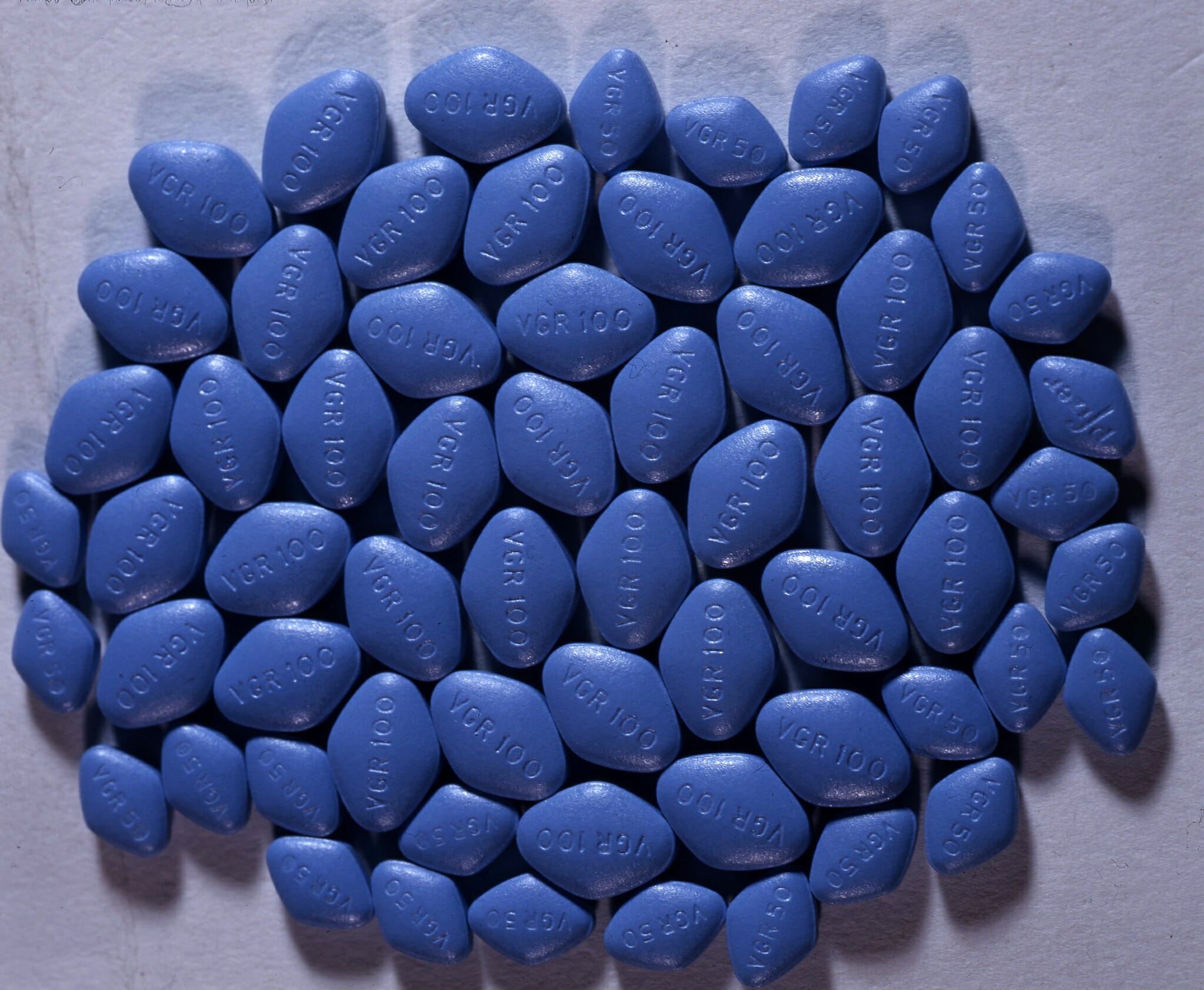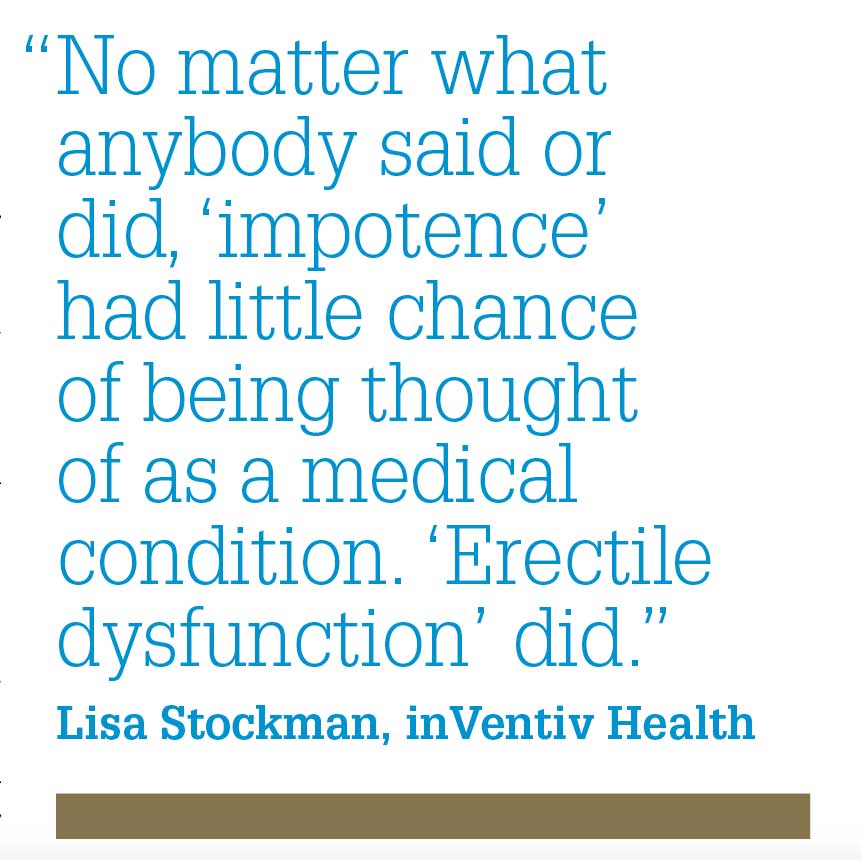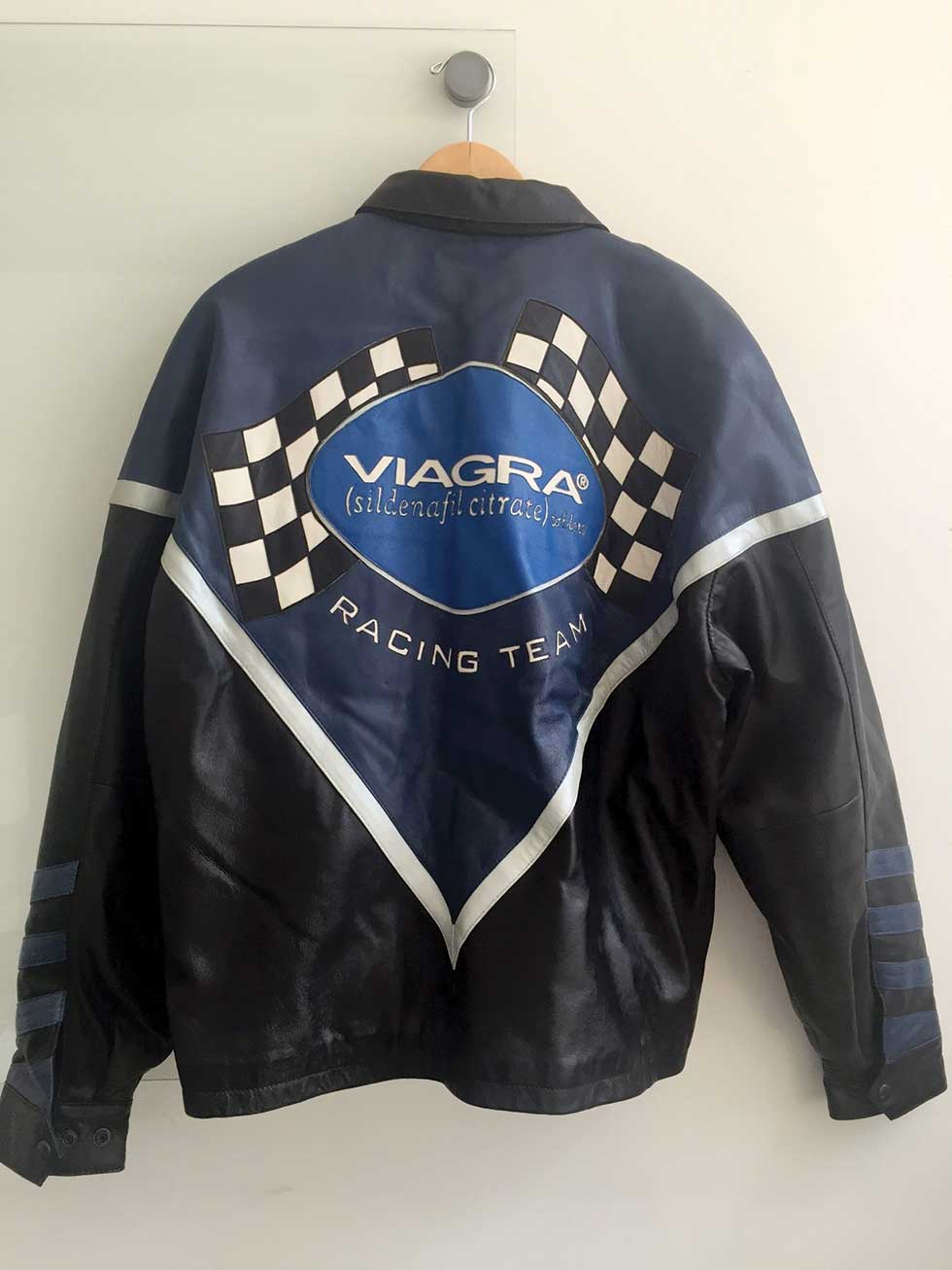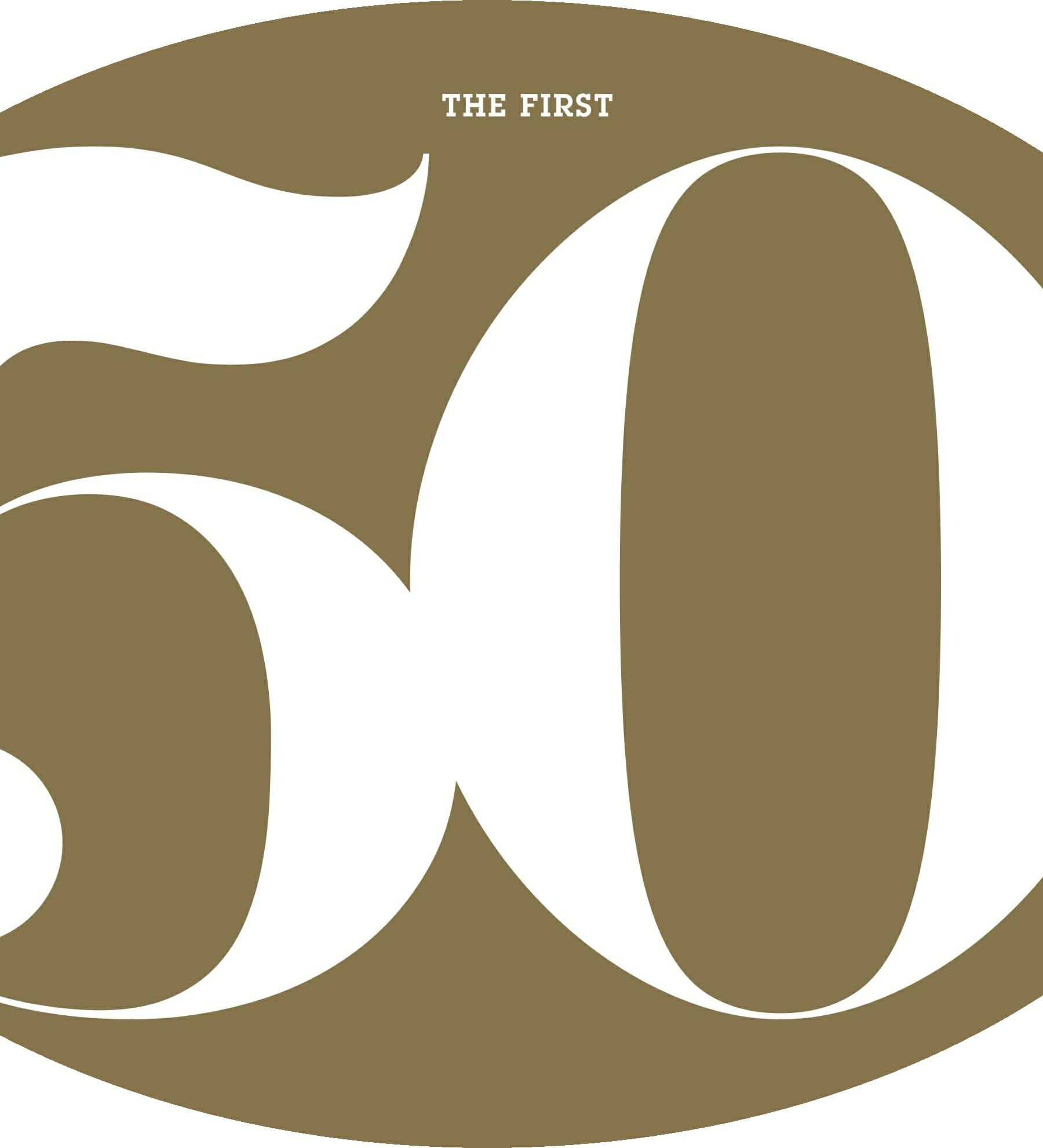 By recasting impotence as “erectile dysfunction,” Pfizer and its marketing partners were able to traditional attitudes.
By recasting impotence as “erectile dysfunction,” Pfizer and its marketing partners were able to traditional attitudes.
When Pfizer launched Viagra, in 1998, it did so with eyes wide open about the immediate impact the drug would have — on patients, of course, but also on physicians, the health media, and purveyors of late-night chuckles. What the company may not have anticipated was the longer-term influence that Viagra’s wild success would wield on pharma marketing as a discipline.
Marketers who worked on the drug over the years, however, were not blind to the phenomenon that was brewing. “Right from the outset, it felt as if we were working on a big brand,” recalls Michael Sanzen, then VP, group copy supervisor at Cline Davis & Mann, who worked with VP, group account supervisor Ken Begasse on a broad range of HCP- and patient-communication tasks during Viagra’s infancy (the two would cofound Concentric Health Experience in 2002, where they continue to work today).
“It was one of the first times in the pharma space where we were really ideating on what a brand needed to be based on the customer perspective, not solely on the product perspective,” Sanzen says.
Read more about the industry’s milestone moments in MM&M‘s 50th Anniversary issue.
McCann HumanCare SVP, group creative director Doug Welch, who co-led his agency’s successful pitch for a big piece of Viagra business in 2004, agrees. “It felt as if we were in the middle of something big,” he says. “Would we be quite where we are today in the candor with which we discuss sensitive conditions? I honestly doubt it.”
While Pfizer declined an interview request about Viagra’s enduring legacy, a handful of marketers who worked on the campaign during its early days were happy to take a trip down memory lane. Without further ado, here are the seven ways that Pfizer’s marketing of Viagra proved transformational — for Pfizer, sure, but also for the business as a whole.
1. It provided the blueprint for medicalizing a supposed lifestyle condition.
 Ultimately, this is Viagra’s great legacy from a marketing perspective. Among Pfizer’s greatest concerns during the run-up to launch was that Viagra wouldn’t be taken seriously enough as a medication and that the media would downplay its medical utility in favor of cheap boner-pill gags. The brand and marketing teams realized that such a perception could limit the drug’s impact, both on the lives of needy patients and, well, the bottom line.
Ultimately, this is Viagra’s great legacy from a marketing perspective. Among Pfizer’s greatest concerns during the run-up to launch was that Viagra wouldn’t be taken seriously enough as a medication and that the media would downplay its medical utility in favor of cheap boner-pill gags. The brand and marketing teams realized that such a perception could limit the drug’s impact, both on the lives of needy patients and, well, the bottom line.
The solution was a focused educational effort that began well before Viagra hit the market. Ultimately, the effort went down in pharma marketing lore as the first and most effective medicalization campaign.
See also: How five therapies changed the course of pharma history
“We had to give physicians a reason to have a conversation about this,” recalls Begasse. “That meant linking [erectile dysfunction] to the things physicians were traditionally concerned about — diabetes and cardiac conditions in particular. In so many words, it was pretty much, ‘Hey, doc, you should be asking about erectile dysfunction, because it often happens 18 months before a cardiac event.’”
That same message was emphasized in Viagra’s media strategy. “We knew the nature of the condition was going to lead to challenges, because maybe there were people who didn’t take it seriously,” says Lisa Stockman, then a team leader at Chandler Chicco Agency and now president, communications at inVentiv Health, Chandler Chicco’s parent company. “You can’t totally get away from that, but we tried to show the impact of ED on men, in terms of emotional well-being and depression, beyond the effect on their sex lives.”
2. It created a new therapeutic category.
Well, not really: Impotence, as it was then known, didn’t suddenly emerge in the late 1990s. But by the time Viagra was invented, impotence was thoroughly stigmatized, as both a condition and a word. It wasn’t on anyone’s list of favored topics to discuss — that’s probably the polite way to put it.
By recasting impotence as “erectile dysfunction,” then, Pfizer and its marketing partners were able to dodge this toxic attitudinal predisposition. “In just about every other category, the lexicon was already set. Here, we had the chance to engage on different terms,” Stockman says. “No matter what anybody said or did, ‘impotence’ had little chance of being thought of as a medical condition. ‘Erectile dysfunction’ did.”
See also: Pfizer ad celebrates the sweat and science behind the little blue pills
3. It enabled more candid conversations with physicians.
The shift from “impotence” to “erectile dysfunction” may originally have been made with patients in mind, but it had a secondary benefit of appealing to physicians. As hard as it may be to believe with 18 years of hindsight, Viagra was a tough sell for the physician audience. Yes, it had sexuality as part of its brand promise, but it was designed to treat a physical condition that many doctors believed was in no small part psychological in nature. That hesitancy had to be addressed sooner rather than later.
“It was kind of a hidden barrier,” Sanzen says. “There was so much taboo around discussions with patients about sex and relationships. [Physicians] didn’t think it was their place to have that conversation. Maybe the language choice gave them a little more of an opening.”
“Curling up in bed with a favorite book is nice, but I think women would rather curl up with their favorite man,” actress Kelly King said during a recent ad.
4. It ushered in the era of the celebrity spokesperson.
Longtime senator, former presidential candidate, and honored war veteran Bob Dole wasn’t the first celebrity to endorse a pharmaceutical product in the DTC era. But when he appeared in a Viagra commercial in 1998, he revolutionized the way such personalities participated in pharma campaigns — and in doing so, encouraged pharma to aim higher in its pursuit of celebrity endorsers and advocates.
“Nothing against Howard Stern, but Pfizer didn’t pick Howard Stern,” notes Stockman. “It picked Bob Dole, who was a credible, decorated American. It was a very purposeful choice.”
Dole’s first Viagra spot looks an awful lot like a political ad. He wears the traditional uniform of dark suit and red power tie; the background music could well have been lifted from a military procession. But the message Dole delivers could not have been any more straightforward: “It’s a little embarrassing to talk about ED, but it’s so important to millions of men and their partners that I decided to talk about it publicly.”
See also: 50 celebrity healthcare endorsements
By addressing the issue head-on and personalizing it — something, it’s worth noting, that Viagra’s early-2000s army of NASCAR endorsers never did — Dole injected a note of humanity into the conversation around the drug. This became the blueprint for all celeb campaigns that followed: Find a celebrity who has been directly affected by a disease or condition (Dole was in the wake of his treatment for prostate cancer), then let him or her testify.
It worked. “After the commercial started to air, the funny ha-ha coverage started to fall off. That was the moment where the media started to focus on the impact on people’s lives,” Stockman says.
5. It obliterated the media’s reluctance to cover “embarrassing” health-related stories.
As one of the architects of the initial Viagra media push, Stockman remembers the months before and after launch as somewhat of a blur. She and other members of the Viagra media team spent much of it in an ad hoc war room at Pfizer headquarters on East 42nd St. in New York City. The experience left enough of an impression that she can still reel stats off the top of her head: two billion impressions within a month and 865 million audience impressions within 48 hours of FDA approval.
Did she have any idea that Viagra would prove so irresistible to the media? Stockman laughs. “We knew. We knew and we didn’t know,” she quips. Visibility was never a concern. Making sure the drug was “appropriately covered,” in her words, clearly was.
That’s why she and other individuals and institutions who worked media and PR on Viagra’s behalf sat down with physicians and scientists well in advance of the drug’s debut. Their counsel, particularly as it pertained to the underexplained medical and psychological impact of ED, proved invaluable. The issue then became doing everything possible to ensure that such concerns weren’t lost amid the pop-cultural whirlwind into which Viagra would soon venture.
See also: Experts: Sprout needs to show Addyi is not Viagra for women
That, Stockman says, is as much a part of the drug’s legacy as anything else. “It was the first time that a medical product made that leap into pop culture and the family living room conversation,” she notes. “Before, there wasn’t any acknowledgment that you’d take a medicine for something that might affect you in your prime. The thinking was ‘medicines are things that old people take.’”
Nobody on Team Viagra was surprised when the drug made an appearance on the cover of Time — and nobody failed to recognize the significance of that coverage, either. “Before Viagra, there wasn’t much discussion on the nightly news about these topics. America was a little more conservative back then — and the media certainly was,” Stockman continues. “This marked a pivot point for the coverage of pharmaceutical products. Now the media will talk about pretty much anything.”
 Pfizer encouraged anyone and everyone charged with marketing Viagra to push the creative envelope.
Pfizer encouraged anyone and everyone charged with marketing Viagra to push the creative envelope.
6. It freed drug marketers to rethink their sales materials.
As much as early Viagra marketing focused on breaking down patient reluctance toward treatment and conversation, Pfizer knew that such an effort wouldn’t pay immediate dividends. To that end, it encouraged anyone and everyone charged with marketing Viagra to push the creative envelope.
So, instead of typically sized and formatted waiting room brochures, Pfizer conveyed information about Viagra in Voices, a custom publication. In it, sports and entertainment personalities (MLB’s Rafael Palmeiro, NASCAR driver Mark Martin, members of Earth, Wind & Fire, for instance) weighed in on the importance of men taking charge of their health. Voices also attempted to dispel myths about erectile dysfunction (the aforementioned fallacy, for instance, that ED is generally triggered by psychological factors).
See also: Omnichannel marketing tech opens new doors for engagement
“Men could pick [Voices] up in the office and the other patients wouldn’t necessarily recognize it as a Viagra piece,” Sanzen says. “It was a targeted, undercover way of getting to that patient.”
Team Viagra similarly attempted to rethink the typical drug starter kit, which hadn’t evolved much beyond its initial iteration of three pills in a box. While the Viagra kit derived some packaging inspiration from the Z-Pak, it departed from the norm in everything from the nonclinical language it employed to the number of pills it contained.
“We recognized that for these men, who had been suffering in silence for a long time, the first experience was everything,” Begasse recalls. “Clinically, we knew it might take a few tries for them to get the full effect — so by adding more pills [to the kit], it wasn’t that we were giving away free experiences. We were just doing whatever we could to make that first one a good one.”
7. It made a whole lot of careers.
Stockman and the Concentric duo of Begasse and Sanzen downplay the effect the work they did early in their professional lives on Viagra had on everything that followed. But they acknowledge the immediate increase in profile enjoyed by many of the individuals who played a leading role in the early days of Viagra marketing. Put it this way: Nobody had any problem getting their phone calls returned after that.
“Well, I’m still here,” Stockman says with a self-deprecating laugh. “It put Chandler Chicco on the map. Between Viagra in 1998 and Celebrex in 1999, we came to be known as the ‘blockbuster’ agency. Whether or not that was accurate, it wasn’t a bad thing to have out there.”
See also: What pharma companies and agencies can learn from Amazon
Sanzen feels the same way about his work on Viagra and its effect on everything that followed. “Creatively for us, it was a lifetime’s worth of experience in a matter of a couple of years. We walked out of there feeling as though we’d worked with 10 brands over the course of 15 years, rather than one brand over the course of two,” he says. “We’re probably still drawing on that experience now. It’s rare for a single brand to give you that much fuel.”
Begasse agrees, adding, “You know what Malcolm Gladwell says, that once you do anything for 10,000 hours you become an expert? Well, we amassed 20,000 hours of experience on that one brand alone. Add [his and Sanzen’s work on] Lipitor to that, and you couldn’t write a better script for two guys who were motivated and had ambitions in this industry.”
From the October 02, 2016 Issue of MM+M - Medical Marketing and Media







